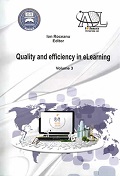DIDACTIC METHODS, PROCEDURES AND DIGITAL TECHNIQUES FOR ANALYSING AND INTERPRETING THE IMAGES IN VISUAL EDUCATION
DIDACTIC METHODS, PROCEDURES AND DIGITAL TECHNIQUES FOR ANALYSING AND INTERPRETING THE IMAGES IN VISUAL EDUCATION
Author(s): Iulian-Dalin TomaSubject(s): Education
Published by: Carol I National Defence University Publishing House
Keywords: visual education; communication; digital working techniques; image analysis
Summary/Abstract: This paper presents an investigation of the way in which information and communication technology influences in a major way the way of teaching, learning experimenting and evaluation of different activities in visual arts. To be more precise the studies and the experiments that have been developed since 2000, for pre-university education, particularly at the level of the gymnasium (in formal and non formal education as well) demonstrates the importance of adapting traditional pedagogical methodology by using digital ones. This aspect has leaded to a major restructuration of the relationship student – teacher – art tutor as it was remodelled by a new dimension, the virtual space. This type of dimension is implicated in enlarging the communication aria and developing communication. The role of each actor of the process is changed as the find each other on different positions, in virtual place. The study is carried on two main research lines, both fundamental for visual art pedagogy, didactic methods, associated procedures, and digital working techniques, specific for image analysis, therefore didactic methods, digital techniques and procedures for image interpretation, are aspects to be taken into consideration as well. The new approach in EVC (education and visual communication) opens new perspectives for all kind of fine arts and visual experiments due to which artistic performances can be improved and turned into a continuous process, reversible in time and space. We are confident that the results of those experiences and research are going to play in important part in reshaping and improving the national curriculum for visual education for gymnasium section.
Journal: Conference proceedings of »eLearning and Software for Education« (eLSE)
- Issue Year: 9/2013
- Issue No: 03
- Page Range: 221-230
- Page Count: 10
- Language: English

